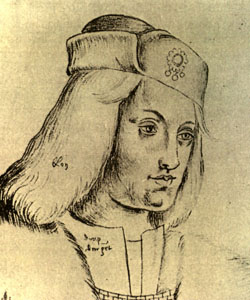| Perkin Warbeck  Born: c. 1474 Born: c. 1474
Birthplace: Tournai, Belgium
Died: 23-Nov-1499
Location of death: London, England
Cause of death: Execution
Gender: Male
Race or Ethnicity: White
Occupation: Hoaxer Nationality: England
Executive summary: Pretender to English throne Perkin Warbeck, pretender to the throne of England, was the son of Jehan de Werbecque, a poor burgess of Tournay in Flanders and of his wife Katherine de Faro. The exact date of his birth is unknown, but as he represented himself as having been nine years old in 1483, it must have taken place in, or close on, 1474. His confession made at the end of his life was an account of his early years which is to some extent supported by other testimony. The names of his father and other relations whom he mentions have been found in the municipal records of Tournay, and the official description of them agrees with his statements. According to this version, which may be accepted as substantially true, he was brought up at Antwerp by a cousin Jehan Stienbecks, and served a succession of employers as a boy servant. He was for a time with an Englishman John Strewe at Middleburg, and then accompanied Lady Brampton, the wife of an exiled partisan of the house of York, to Portugal. He was for a year employed by a Portuguese knight whom he described as having only one eye, and whom he names Vacz de Cogna (Vaz da Cunha?). In 1491 he was at Cork as the servant of a Breton silk merchant Pregent (Pierre Jean) Meno. Ireland was strongly attached to the house of York, and was full of intrigue against King Henry VII. Perkin says that the people seeing him dressed in the silks of his master took him for a person of distinction, and insisted that he must be either the son of George, duke of Clarence, or a bastard of Richard III. He was more or less encouraged by the earls of Desmond and Kildare. The facts are ill recorded, but it is safe to presume that intriguers who wished to disturb the government of Henry VII took advantage of a popular delusion, and made use of the lad as a tool. At this time he spoke English badly. By 1492 he had become sufficiently notorious to attract the attention of King Henry's government and of foreign sovereigns. He was in that year summoned to Flanders by Margaret, the widowed duchess of Burgundy, and sister of Edward IV, who was the main support of the Yorkist exiles, and who was the enemy of Henry VII for family reasons and for personal reasons also, for she wished to extort from him the payment of the balance of her dowry. She found the impostor useful as a means of injuring the king of England. Several European sovereigns were moved to help him by the same kind of reason. The suppositions that he was the son of Clarence or of Richard III, were discarded in favor of the more useful hypothesis that he was Richard, duke of York, the younger of the two sons of Edward IV, murdered in the Tower of London. King Charles VIII of France, the counsellors of the youthful duke of Burgundy, the duke's father Maximilian, king of the Romans, and James IV of Scotland, none of whom can have been really deceived, took up his cause more or less actively. He was entertained in France, and was taken by Maximilian to attend the funeral of the emperor Frederick III in 1493. At Vienna he was treated as the lawful king of England. He was naturally the cause of considerable anxiety to the English government, which was well acquainted with his real history, and made attempts to get him seized. His protectors entered into negotiations which in fact turned on the question whether more was to be gained by supporting him, or by giving him up. An appeal to Isabella, queen of Castile, met with no response. In July 1495 he was provided with a few ships and men by Maximilian, now emperor, and he appeared on the coast of Kent. No movement in his favor took place. A few of his followers who landed were cut off, and he went on to Ireland to join the earl of Desmond in Munster. After an unsuccessful attack on Waterford in August, he fled to Scotland. Here King James IV showed him favor, and arranged a marriage for him with Catherine Gordon, daughter of the earl of Huntly. He was helped to make a short inroad into Northumberland, but the intervention of the Spanish government brought about a peace between England and Scotland. In 1497 Perkin was sent on his travels again with two or three small vessels, and accompanied by his wife, who had borne him one or two children. After some obscure adventures in Ireland, he landed at Whitesand Bay, near the Land's End, on the 7th of September, and was joined by a crowd of the country people, who had been recently in revolt against excessive taxation. He advanced to Exeter, but was unable to master the town. On the approach of the royal troops he deserted his followers, and ran for refuge to the sanctuary of Beaulieu in Hampshire. He then surrendered. His wife was kindly treated and placed in the household of Henry's queen Elizabeth. Perkin was compelled to make two ignominious public confessions at Westminster, and in Cheapside on the 15th and 19th of June 1498. On the 23rd of November 1499 he was hanged on a charge of endeavoring to escape from the Tower with the imprisoned earl of Warwick.
Father: Jehan de Werbecque
Mother: Katherine de Faro
Do you know something we don't?
Submit a correction or make a comment about this profile
Copyright ©2019 Soylent Communications
|